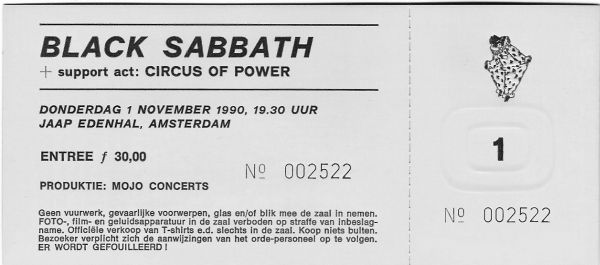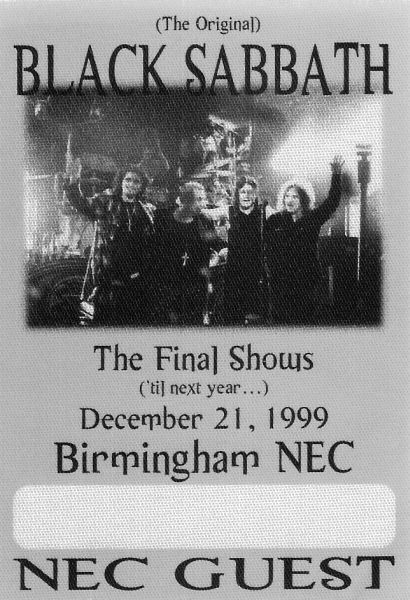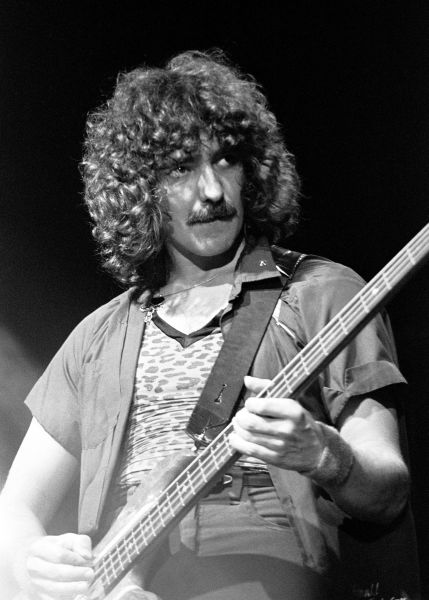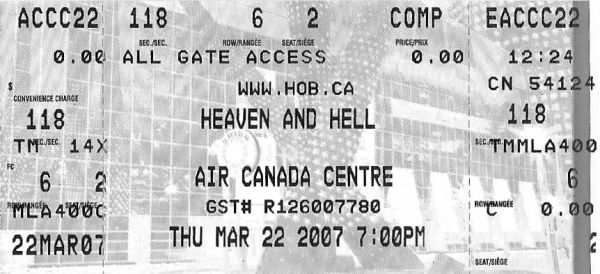10
Black Sabbath’s Tour Mates Through History
Sabbath have shared bills with myriad bands of myriad types over the years. Here’s the story, summarized by era, of some of the bands that got big, bands nobody ever heard from again, legendary mismatches and classic festival packages.
Late ’60s
At this point Sabbath wasn’t Sabbath, but Polka Tulk Blues Band, Polka Tulk and Earth. Plus with no Black Sabbath to invent heavy metal, the boys had no choice but to play with blues bands, thematically, those from a†round Birmingham and under the wing of Sabbath’s first manager Jim Simpson, a mover, shaker, and local expert when it came to both jazz and the blues. Ergo, at this time, the guys played with Bakerloo (or Bakerloo Blues Band), Locomotive, Tea & Symphony, plus headliners like John Mayall & the Bluesbreakers, Ten Years After, Jethro Tull, and Jon Hiseman’s Colosseum. You look at that bunch and yes, you can see that it was a time of impatience with the British blues boom, a time when blues was still at the root, but bands were doing more with it—in Sabbath’s case, lots more.
Black Sabbath
The tour for the first album included one-off billings of all sizes, the band doing small clubs through to festivals. What is interesting is the spirit or vibe of the bands on offer, how they fit the hard rock or hard prog or hard blues creativity of a new flash label like Vertigo (Sabbath’s label), and similar hip imprints of majors such as Harvest. In that light, the list includes Blodwyn Pig, Chicken Shack, Clark Hutchinson, Family, Golden Earring, Groundhogs, Gypsy, Hardin & York, Hard Meat, Jody Grind, Keef Hartley Band, Judas Jump, Juicy Lucy, Killing Floor, King Crimson, May Blitz, Medicine Head, Rare Bird, Rhinoceros, Savoy Brown, Steamhammer, Stray, Taste, Ten Wheel Drive, Uriah Heep, Van Der Graaf Generator, Writing on the Wall, and Yes. Even in Germany, the sort of “collectible hard rocking prog band on boutique label” vibe was maintained, through a Sabbath/Frumpy/Hairy Chapter billing. Continuing on with the theme of our first section, this was a whole raft of bands moving on from the restrictive blues boom into a new golden age of creativity in rock, and if any huge generalization can be suggested, you’d have it call what these bands were doing progressive rock of a heavy and driving nature.
Paranoid
Many one-off, jump-on/jump-off shows remain, but the Sabs also start seeing limited multiple dates with the same acts, mainly because U.S. touring begins for the first time. However, first it’s a bunch of dates with early Vertigo act Manfred Mann Chapter II in Europe, underscoring yet again the hard prog theme afoot here. In the states, Sabbath backs up Alice Cooper, Canned Heat, Jethro Tull, Rod Stewart & the Faces, James Gang, and Savoy Brown. Just after the release of Paranoid, the band is billed with haunting proggers Curved Air and the fairly heavy Freedom for a smattering of dates in the UK. Back in the States, the band is a regular opener for Fleetwood Mac (hard blues) and for Mountain (much harder blues), Mountain sometimes cited as America’s first heavy metal band, an intensification of Cream. Interestingly, Sabbath also plays a handful of shows with Sir Lord Baltimore, who soon became a collectible (but frankly weak tea) facsimile of Sabbath.
Master of Reality
The Master of Reality tour begins in the summer of ’71 in America with a bewildering array of billings, Sabbath sharing the stage with Black Oak Arkansas, Alice Cooper, the Grease Band, the Guess Who, Humble Pie, King Crimson, Stoneground, Sweathog (quite a few dates—Sweathog was part of Frank Barsalona’s Premier Talent Agency, which also included Sabbath), Three Dog Night, Edgar Winter’s White Trash, and Yes. There are even two dates with Led Zeppelin, mid-September in upstate New York. Back in the UK in late ’71 and into early ’72, the band logs a pile of dates with killer, underrated hard prog band Wild Turkey, the first few with Nazareth on the bill as well. Wild Turkey accompanies the band on another U.S. leg in March of ’72, this time with Yes headlining, illustrative of this opinion you hear out of old-timers that dance cards in the ’70s could feature quite wildly different bands, the logical reason being that there were fewer bands out and around, so there was less of a need to segment bands and fans into the micro-genres and pointed profiles we see today.
Vol 4
Dates for Vol 4 begin with varied bills, featuring the likes of Argent, Bedlam, Blue Öyster Cult (Columbia Records’ answer to Black Sabbath), Cactus (America’s “Led Zeppelin”), Captain Beyond (see Sir Lord Baltimore above), Groundhogs, Mark Almond, and for a dozen or so shows at the end of the U.S. leg in September, fellow Patrick Meehan/Wilf Pine servants Gentle Giant. On the band’s first Australian jaunt, they would play, congruously, with the legendary Buffalo, who were the only band signed to Vertigo outside of the UK, and wallopingly heavy to boot. New Zealand blues rockers Ticket were also a mainstay of this short visit. Back in Europe in early ’73, and the Sabs are paired with Badger and Necromandus, a band of Sabbath-camp insiders being groomed as a baby Sabbath (sadly, no record ever emerged).
Sabbath Bloody Sabbath
The Sabbath Bloody Sabbath tour kicks off in the UK and Europe with Highway supporting. U.S. dates commencing January 31, 1974, find Sabbath headlining with Bedlam as backup, Bedlam issuing one record that included future Sabbath drummer Cozy Powell in the band. In May and June of ’74, Sabbath are back in the UK with southern boogie rockers Black Oak Arkansas supporting, heavier and wilder live than they were on record. A return trip to Australia finds none other than a young AC/DC as support act.
Sabotage
The Sabotage tour kicks off in the States with bands jumping on and off as Sabbath support, scheduling permitting. Here we see Brownsville Station, Jo Jo Gunne, Peter Frampton, Kiss, Lynyrd Skynyrd, Mahogany Rush, Slade, Ruby Starr & Grey Ghost, Status Quo, and Leslie West Band all trying to work their way up the ladder. Back in the UK, support is Bandy Legs, who would become NWOBHM titans Quartz, produced by Tony Iommi, future keyboardist Geoff Nicholls as member. Europe features a couple of shows with ZZ Top, and then it’s back to America, where future legends Kiss, Aerosmith, and Kansas throw in an appearance each.
Technical Ecstasy
October 1976 finds Sabbath out with Boston, the guys looking on forlornly as Tom Scholz and crew’s debut album eventually blew up to such proportions, inverting the billing wouldn’t have been illogical. Other lesser (and less frequent) guests on the Technical Ecstasy tour include Canadian proto-metallers Moxy, Target, Mother’s Finest (heavy southern rock act), Bob Seger (yet to break big), and Heart (ditto). Target stick around for more dates in early ’77, but the most historically important guest is Ted Nugent, just about to break big with Free for All. Notably, Journey log a few U.S. dates as well, just before Sabbath return to the UK, Nutz (later Rage, again, hard blues rock) supporting. And finally, April ’77 finds the band touring Europe with a pestering AC/DC heating up crowds perhaps a bit too dangerously close to crisp. Of note, a handful of German dates also find on the bill a humbled Ian Gillan fronting his ill-fitting jazz rock outfit the Ian Gillan Band.
Never Say Die
The big story of the Never Say Die tour is the presence of a white-hot Van Halen backing up a waning, tired Sabbath all over Europe and America (on upward of seventy dates, by far the longest pairing of Sabbath’s career thus far), this becoming over time one of the most famous, apocryphal stories in rock about a support act destroying the headliner (see chapter 13). Adding insult to injury, Sabbath are also included on a two-date package where previous support act Boston are indeed now the headliner. Other occasional backups include Lucifer’s Friend, Head East, and the Ramones, the last indicating a shift in public consciousness toward punk, but a gradual one, with the Ramones often showing up on hard rock bills of the day.

A rare satin, or “sticky,” pass from the ’80s.
Ronnie James Dio Era Pt. 1: Heaven and Hell, Mob Rules
Usher in the Ronnie James Dio era, and the band pick Girlschool as backup for a four-night Hammersmith Odeon stand, and then female-fronted French act Shakin’ Street, like the Sabs, managed by Sandy Pearlman, for the rest of the European tour. Over in America, we get the Black and Blue tour, the Sabs coheadlining with Blue Öyster Cult, also managed by Sandy Pearlman. The crews feud, the bands feud, Sandy in the middle of it, and to add more drama, Bill Ward takes a flyer and is quickly replaced by Vinny Appice (see chapter 15). Many of the shows with BÖC feature additional support acts, such as Saxon, Molly Hatchet, Sammy Hagar, Riot, more Shakin’ Street, and more Girlschool. In Australia, support is AC/DC-derivative ruffians Rose Tattoo. Back to the UK to close things out, weirdly, you have underground NWOBHMers A II Z and Canadian pop/prog/metal genre-defiers (and close to this writer’s favorite band of all-time) Max Webster. The massive U.S. tour for Mob Rules includes as support, in large chunks and in chronological order, Alvin Lee Band, Doc Holliday, Wrabit, the Outlaws, then Doc Holliday again, and, finally, Johnny Van Zant. Why three of those bands are essentially southern rock acts, I have no idea. And how obscure Canadian AORists Wrabit got on the tour, well, I also have no idea about that.

Many thought Tony should have knocked it on the head at this point, given the band’s revolving-door lineup changes.
Born Again
For the savage Born Again album, Sabbath crowds get warmed up with some stronger stuff, namely Pretty Maids in Scandinavia, Diamond Head on the mainland, and a breaking Quiet Riot in America (Metal Health would go platinum six times, while Born Again didn’t even hit gold). As well, Nazareth support on some Canadian dates, and Night Ranger do a few U.S. dates later in the tour cycle.
Seventh Star
The band in shambles, Sabbath have more blood on their hands from support act W.A.S.P. Roughly half these dates feature Glenn Hughes at the mic, half Ray Gillen. Anthrax also do a few of these dates. O’er to Europe, and the support is the hyped Zeno, Euro-AORists led by Uli Jon Roth’s younger brother Zeno Roth.

American biker rockers Circus of Power got considerable exposure in 1990, landing the sole support slot for the entirety of Black Sabbath’s Tyr tour.
Tony Martin Era Pt. 1: The Eternal Idol, Headless Cross, Tyr
Early in the tour for The Eternal Idol, Sabbath are supported by American power metallers Virgin Steele, unknowns in their native America but somewhat in possession of a career in Europe, where they do these gigs. Motörhead and Cro-Mags also support the odd date. Moving forward, the Headless Cross tour begins in America with Kingdom Come and Gene Simmons act Silent Rage supporting. In Europe it’s German pure metallers Axxis, with a prolonged stay in the USSR featuring a return visit from Girlschool. Support for the Tyr dates comes courtesy of biker rockers Circus of Power, all over the UK and Europe, close to fifty dates in all. There is no North American tour.
Ronnie James Dio Era Pt. 2: Dehumanizer
With Ronnie back in the band for a dirty, grungy “modern” record, the band pick as supports similarly current bands, namely Danzig, Prong, and Skew Siskin, with Testament and Exodus supplying some upstart thrash to keep things heavy start to finish. Like Priest picking superheavy Pantera and Annihilator for support on the Painkiller tour, this is a case of old gods trying to stay in shape, stay on their toes, stay relevant.
Tony Martin Era Pt. 1: Cross Purposes, Forbidden
For the Cross Purposes dates, the Sabs construct their heaviest bill yet, taking Motörhead and Morbid Angel out for a raft of North American dates, and then Godspeed and new doomsters Cathedral grinding it out over in Europe. Come Forbidden, Motörhead follow up one Sabbath tour with another; this time Morbid Angel are switched out for doomy atmospheric metal buzz band Tiamat.

Neil Murray, Cozy Powell, and Tony Martin are featured prominently on this tour laminate, an amusing reproduction of the Forbidden album sleeve.
Reunion
Sabbath’s first tour with Ozzy back is as headliner at the second Ozzfest, in ’97. The lineup consists of Sabbath as headliners, plus Ozzy Osbourne, Marilyn Manson, Pantera, Type O Negative, Fear Factory, Machine Head, and Powerman 5000 (and those are just the main-stage acts). The Birmingham shows that are recorded for the Reunion album have Fear Factory as backup. Sabbath tour Europe in June of ’98 with a whole host of backups (and this is because it’s a mix of regular shows and festivals), including Dream Theater, Helloween, Soulfly, Coal Chamber, Neurosis, Pantera, Gamma Ray, Paradise Lost, Deftones, Savatage, and Stratovarius. In ’98, Ozzy headlines Ozzfest with his own band, but Sabbath play the lone UK Ozzfest date, June 20, at Milton Keynes. Sabbath return for Ozzfest ’99, playing the main stage with Rob Zombie, Deftones, Slayer, Primus, Godsmack, and System of a Down. There are also non-Ozzfest dates in support of Reunion, featuring support acts such as Pantera, Deftones, Incubus, and Geezer’s son’s band, Apartment 26. Other non-Ozzfest dates have Drain STH and Godsmack supporting, and, less often, System of a Down and Breed 77. The guys come back to Ozzfest again in ’01, playing with Marilyn Manson, Slipknot, Papa Roach, Linkin Park, Disturbed, Crazy Town, and Black Label Society. Again there is a Milton Keynes date, with a slightly varied lineup. Ozzfest 2004 finds Sabbath playing with Judas Priest, Slayer, Dimmu Borgir, Superjoint Ritual, and Black Label Society. Ozzfest ’05 features Sabbath, Iron Maiden, Mudvayne, Shadows Fall, Black Label Society, In Flames, Velvet Revolver, Slipknot, and Trivium. Sabbath also do festival season in 2005 with a range of support acts, including Soulfly, Black Label Society, and Velvet Revolver.

Given the accurate qualification “The Final Shows (’til next year…)” on this show satin, Birmingham didn’t turn out to be quite as historic an event as we all had thought at the time.

Geezer, ever the band’s fashion plate, adjusts to the demands for a less metal look as the ’70s give way to the ’80s.
Photo by Rich Galbraith

The first of two Heaven & Hell shows attended by the author, this inaugural Toronto stop was an indoor show, allowing for a most favorable presentation of the band’s thoughtful, expensive stage set.
Heaven & Hell “Band” Era
The Ronnie era returns, and Heaven & Hell hit it hard on all cylinders. The 2007 tour begins in Canada with Megadeth and Down supporting, and then into the states, with Megadeth and Machine Head. Over to Europe, and there’s a surprise showing from underground stoner rockers Orange Goblin. Down support in Australia. Back into America, we get Queensryche and Alice Cooper, and then to close out the year in the UK, Iced Earth and Lamb of God. In 2008, the guys embark on the Metal Masters tour, as second billing to Judas Priest, with Motörhead and Testament supporting. The 2009 tour finds the band playing with Axel Rudi Pell in Germany, followed by a huge spate of festival gigs in the summer of ’09, then back to the U.S., where Coheed and Cambria support on most dates.